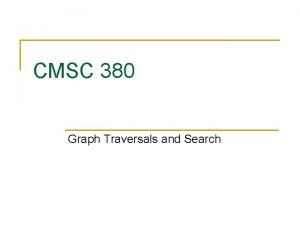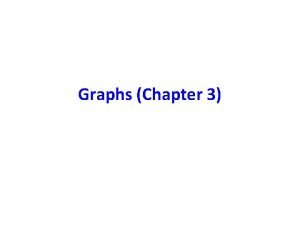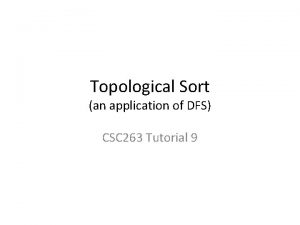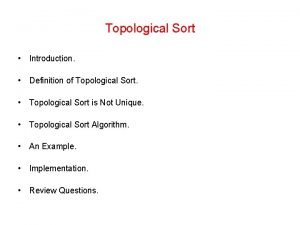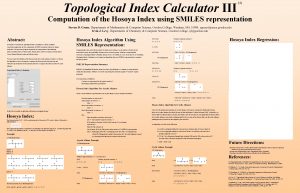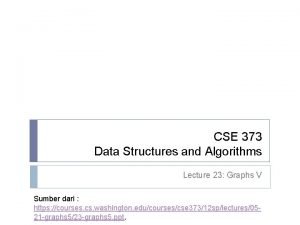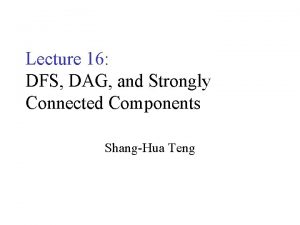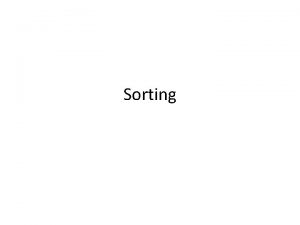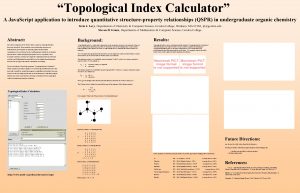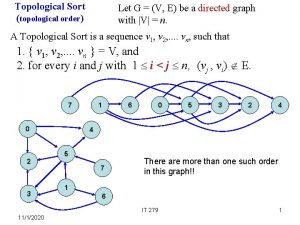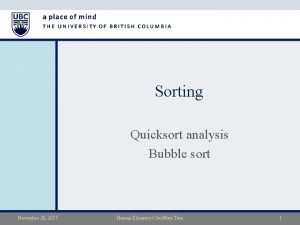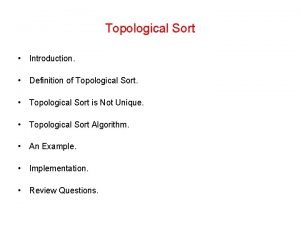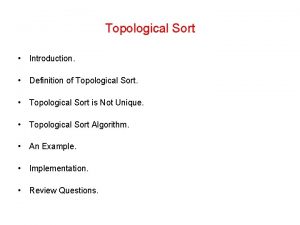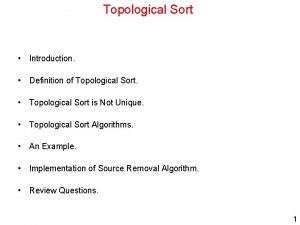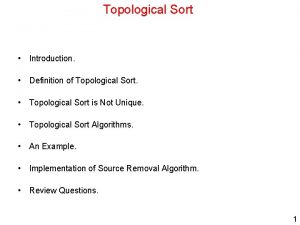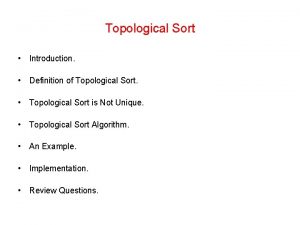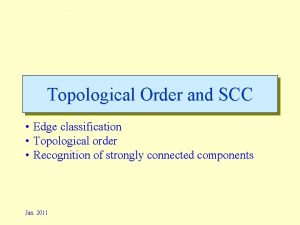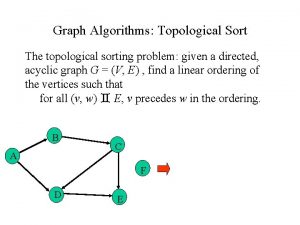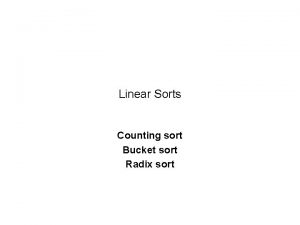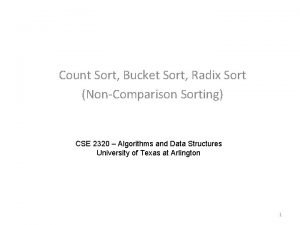Topological Sort topological order Let G V E



















- Slides: 19

Topological Sort (topological order) Let G = (V, E) be a directed graph with |V| = n. A Topological Sort is a sequence v 1, v 2, . . vn, such that 1. { v 1, v 2, . . vn } = V, and 2. for every i and j with 1 i < j n, (vj , vi) E. 7 0 1 6 2 3 2 4 7 There are more than one such order in this graph!! 1 6 IT 279 11/1/2020 5 4 5 3 0 1

Algorithm for finding Topological Sort Principle: vertex with in-degree 0 should be listed first. 2 1 7 Algorithm: 2 7 1 Input G=(V, E) Repeat the following steps until no more vertex left: 1. Find a vertex v with in-degree 0; 2. If no such v and V is not empty, then stop the algorithm; this graph is not acyclic; 3. If such v exists, remove v from V, add v into the sequence of a topological; 4. Update E. 11/1/2020 IT 279 2

Topological Sort (topological order) of an acyclic graph 7 1 6 0 5 3 2 4 4 0 7 5 2 3 11/1/2020 1 IT 279 6 3

If the graph is not acyclic, then there is no topological sort for the graph. Not an acyclic Graph 0 2 4 7 9 1 3 5 8 No way to arrange vertices in this cycle without pointing backwards 6 11/1/2020 IT 279 4

Fail to find a topological sort (topological order) the graph is not acyclic 1 2 8 0 2 4 7 9 1 3 5 8 6 11/1/2020 IT 279 5

Topological Sort (topological order) of an acyclic graph 0 2 8 5 4 3 7 9 6 1 This graph is acyclic 0 2 4 7 9 1 3 5 8 6 11/1/2020 IT 279 6

Topological Sort in C++ // return an array where the first entry is the size of g // or 0 if g is not acyclic; int * graph: : topsort(const Graph & g) { int *topo; Graph temp. G = g; topo = new int[g. size()+1]; topo[0] = g. size(); for (int i=1; i<=topo[0]; i++) { int v = find. Vertexwith. Zero. In(temp. G); if (v == -1) { // g is not acyclic delete [] topo; topo = new int[1]; topo[0] = 0; return topo; } topo[i] = v; remove_v(temp. G, v); } return topo; } 11/1/2020 IT 279 7

Edsger Wybe Dijkstra 1930 -2002 • Algorithm design • Programming languages • Operating systems • Distributed processing • Formal specification and verification 1972 Turing Award “Object-oriented programming is an exceptionally bad idea which could only have originated in California. ” (Well, Sir! You can say that!) Dijkstra Algorithm: To find the shortest path between two vertices in a weighted graph. 11/1/2020 IT 279 8

Common Algorithm Techniques 1. Divide and Conquer. 2. Back Tracking. 3. Greedy Algorithms: algorithms that make decisions based on the current information; and once a decision is made, the decision will not be revised. 4. Dynamic Programming: dynamically update information and change decisions in the course of the computation. 11/1/2020 IT 279 9

Problem: Minimized the number of coins for change for 66 ¢ { 25¢, 10¢, 5¢, 1¢ } What is your strategy? 25¢ 2 50¢ 1 10¢ 5¢ 1¢ 1 1¢ 5 66¢ 16¢ We can use a greedy algorithm to obtain the minimum number of coins. 6¢ 1¢ 0¢ In general, we need dynamic programming to do the job Greedy method 11/1/2020 IT 279 10

Greedy Algorithms Dynamic Programming Problem: Minimized the number of coins for 66¢ { 25¢, 12¢, 5¢, 1¢ } 25¢ 2 50¢ 12¢ 1 12¢ 5¢ 0 0¢ 1¢ 4 4¢ 7 66¢ 16¢ 4¢ 4¢ 0¢ Greedy method 11/1/2020 25¢ 2 50¢ 12¢ 0 0¢ 5¢ 3 15¢ 1¢ 1 1¢ 6 66¢ Dynamic method IT 279 11

Starting Vertex s 2 5 1 b 1 5 c 7 e j 1 g 4 4 q f 7 5 1 h 3 1 9 d 2 2 i 1 a 3 7 k n x p 1 9 11 m 2 3 IT 279 11/1/2020 Final Vertex 12

Starting Vertex s (-1, 0) 2 b (s, 2) 1 2 c (b, 3) 7 1 5 7 3 4 1 9 x (n, 12) Final Vertex 5 1 h (b, 5) 7 k (g, 13) d (a, 4) 2 j (a. 6) f (e, 8) 11 11/1/2020 a (b, 3) 1 g (e, 9) IT 279 1 e (b, 7) 9 i (b, 4) 5 q (d, 5) m (q, 8) 1 n (m, 9) 4 3 p (d, 8) 2 3 13

Finding the shortest path between two vertices Starting Vertex Unweighted Graphs Weighted Graphs 0 0 2 1 7 Final Vertex 11/1/2020 Both are using the greedy algorithm. 7 1 9 2 35 5 3 2 2 1 1 5 12 8 10 w w IT 279 Final Vertex 14

Construct a shortest path Map Starting Vertex 0 1 2 3 1, 0 4 1, 0 2, 1 5 2, 2 x Final Vertex 11/1/2020 0, -1 w-1, y n Final Vertex IT 279 w, x 15

Shortest paths of unweighted graphs // <vertex, <distance, previous vertex in the path>> typedef map<int, pair<double, int> > Path. Map; Path. Map graph: : Unweighted. Shortest. Path(Graph & g, int s) { Path. Map SPMap; // create a bookkeeper; for (Graph: : iterator itr = g. begin(); itr != g. end(); itr++) { SPMap[itr->first] = make_pair(inft, -1); // -1 mean no previous } SPMap[s] = make_pair(0, -1); // s is not done yet. deque<int> candidates; candidates. push_back(s); while (!candidates. empty()) { int v = candidates[0]; candidates. pop_front(); Adjacency. List ADJ = g[v]; for (Adjacency. List: : iterator w=ADJ. begin(); w != ADJ. end(); w++) { if (SPMap[w->first]. first == inft) { SPMap[w->first]. first = SPMap[v]. first+1; SPMap[w->first]. second=v; candidates. push_back(w->first); } // end enqueue next v } // end ADJ interation; all nextvs's next into the queue. } return SPMap; } 11/1/2020 IT 279 16

Construct a shortest path Map for weighted graph Starting Vertex 0 2 5 1 1 1 7, 1 10, 2 8, 4 5 : decided n 11/1/2020 5, 0 3, 1 7 1 9 2, 0 2 4 0, -1 5 3 Final Vertex w-1, y Final Vertex IT 279 w, x 17

Shortest paths of weighted graphs (I) // A Dijkstra's algorithm Path. Map graph: : Shortest. Path(Graph & g, int s) { Path. Map SPMap; map<int, pair<double, bool> > dist_map; // A distance map // for book keeping; for (Graph: : iterator itr = g. begin(); itr != g. end(); itr++) { dist_map[itr->first] = make_pair(inft, false); SPMap[itr->first] = make_pair(inft, -1); } dist_map[s] = make_pair(0, false); // s is not done yet. multimap<double, int> candidates ; // next possible vertices //sorted by their distance. candidates. insert(make_pair(0, s)); // start from s; . . } 11/1/2020 IT 279 18

// A Dijkstra's algorithm Path. Map graph: : Shortest. Path(Graph & g, int s) {. . . while (! candidates. empty()) { int v = candidates. begin()->second; double costs 2 v = candidates. begin()->first; candidates. erase(candidates. begin()); if (dist_map[v]. second) continue; // v is done after pair // (weight v) is inserted; dist_map[v] = make_pair(costs 2 v, true); Adjacency. List ADJ = g[v]; // all not done adjacent vertices // should be candidates for (Adjacency. List: : iterator itr=ADJ. begin(); itr != ADJ. end(); itr++) { int w = itr->first; if (dist_map[w]. second) continue; // this w is done; double cost_via_v = costs 2 v + itr->second; if (cost_via_v < dist_map[w]. first) { dist_map[w] = make_pair(cost_via_v , false); SPMap[w] = make_pair(cost_via_v, v); } candidates. insert(make_pair(cost_via_v, w)); } // end for ADJ iteration; } // end while !candidates. empty() return SPMap; } Shortest paths (II) 11/1/2020 IT 279 19
 John 10:22-28
John 10:22-28 Topological sort pseudocode
Topological sort pseudocode Ioicamp
Ioicamp Topological sort can be implemented by?
Topological sort can be implemented by? Topological sort applications
Topological sort applications Topological sort
Topological sort Topological ordering
Topological ordering Graph topological sort
Graph topological sort Topological sort online
Topological sort online Topological sort bfs
Topological sort bfs Topological sort calculator
Topological sort calculator Topological sort algorithm
Topological sort algorithm Kahn's algorithm python
Kahn's algorithm python Strongly connected graph
Strongly connected graph Difference between insertion sort and bubble sort
Difference between insertion sort and bubble sort Topological sort calculator
Topological sort calculator Topological sort
Topological sort 排序
排序 Quick sort merge sort
Quick sort merge sort Bubble sort vs selection sort
Bubble sort vs selection sort

